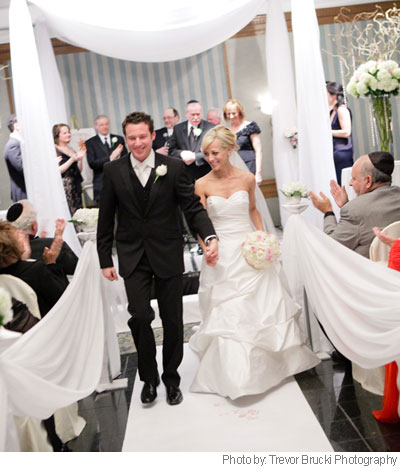 |
Jewish Wedding TraditionsA traditional Jewish wedding is full of meaningful rituals, symbolizing a couple’s life together and their obligations to each other and their faith. Before the Ceremony Before the Ceremony Ketubah: Marriage Contract The Ketubah is the traditional marriage contract. It sets forth the responsibilities the couple accepts as they begin their new lives together. It’s a covenant between the couple promising to take care of each other for life as partners. The couple signs the agreement in the presence of their family and the Rabbi before the wedding at a separate ceremony called Bedeken. Bedeken: Veiling Ceremony After signing the Ketubah, the groom raises the bride’s veil to make sure he is marrying the right women. This tradition stems from the biblical story of Jacob who mistakenly married Rachel’s sister Leah. The veil also separates the groom and bride as a reminder that each will remain distinct individuals as they unite in marriage. The Wedding Ceremony Chuppah: The Wedding Story The wedding ceremony takes place under a Chuppah, the wedding canopy, which dates back to the years the Jewish people spent living in tents in the desert.A Chuppah traditionally is open on all sides, symbolizing the hospitality of the Jewish forefather Abraham, whose tent was always open to strangers. Erusin and Nissuin: The Betrothal and Nuptials The Jewish wedding ceremony consists of two parts: Erusin (betrothal) and Nissuin (nuptials). In the first part, Erusin, there are two blessings, one over wine; the bride and groom drink from the same cup symbolizing the start of their shared life together. After, the couple place a ring on the index finger of their partner's left hand. Following the exchange of the rings the Ketubah is read. In the second part, Nissuin, the Sheva Brachot (seven nuptial blessings) is recited over a second cup of wine. These blessings express gratitude for the miracle of life and the sanctity of marriage. Breaking of the Glass This ritual concludes the ceremony and marks the beginning of the couple’s new life together. A glass is placed under the groom’s right foot and he shatters it by stomping on it. The act is a reminder of the destruction of the temple in Jerusalem and the fragility of human relationships. At this point, it’s customary to shout “Mazel Tov” (congratulations) to the couple. Yichud The tradition of Yichud, which means privacy, commands that immediately following the wedding ceremony, the bride and groom, must spend a few moments alone together. According to Jewish law and custom, a man and woman couldn’t be alone together unless they were married; this was traditionally when the marriage was consummated. Seudat Mitzvah The wedding is then celebrated by a festive meal, complete with dancing and rejoicing. The bride and groom are joined in the Hora, the traditional celebratory dance. Related Articles Spanish Wedding Traditions French Wedding Traditions First Nations Wedding Traditions |
|

